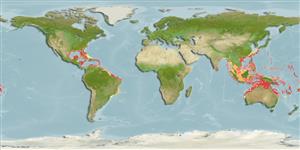Common names from other countries
Environment: milieu / climate zone / depth range / distribution range
Écologie
; saumâtre; profondeur 1 - 91 m (Ref. 108813). Tropical
Indo-Pacific and Western Atlantic: Caribbean wide.
Length at first maturity / Taille / Poids / Âge
Maturity: Lm ? range ? - ? cm Max length : 60.0 cm TL mâle / non sexé; (Ref. 415)
Description synthétique
Morphologie
Sprawling ramose branches, with spiky surface up to 60 cm long; 1 - 5 cm wide. Black with green patches internally and externally. Oscula 0.1 - 0.3 cm in diameter, on side of branches (Ref. 415). Smaller specimens grows as lobes, runners, massive or encrusting. Surface: covered with conules; mostly or entirely smooth for small specimens. Sometimes greenish-yellow. Tough consistency; resilient and barely compressible. Exudate is dark purplish when squeezed. Oscules are scattered or in a row, slightly raised on small lobes and surrounded by a thin collar (Ref. 85482).
Life cycle and mating behavior
Maturité | Reproduction | Frai | Œufs | Fécondité | Larves
Members of the class Demospongiae are hermaphroditic. Life cycle: The zygote develops into parenchymella larva (free-swimming) before settling down on a substrate where it grows into a young sponge.
Collin, R., M.C. Díaz, J. Norenburg, R.M. Rocha, J.A. Sánchez, M. Schulze, A. Schwartz and A. Valdés. 2005. (Ref. 415)
Statut dans la liste rouge de l'IUCN (Ref. 130435: Version 2024-1)
statut CITES (Ref. 108899)
Not Evaluated
Not Evaluated
Menace pour l'homme
Harmless
Utilisations par l'homme
| FishSource |
Outils
Plus d'informations
Taille/ÂgeCroissanceLongueur-poidsLongueur-longueurMorphologieLarvesAbondance
Sources Internet
Estimates based on models
Preferred temperature
(Ref.
115969): 23.9 - 28.9, mean 27.5 (based on 1216 cells).
Vulnérabilité
Moderate vulnerability (44 of 100).
Catégorie de prix
Unknown.
